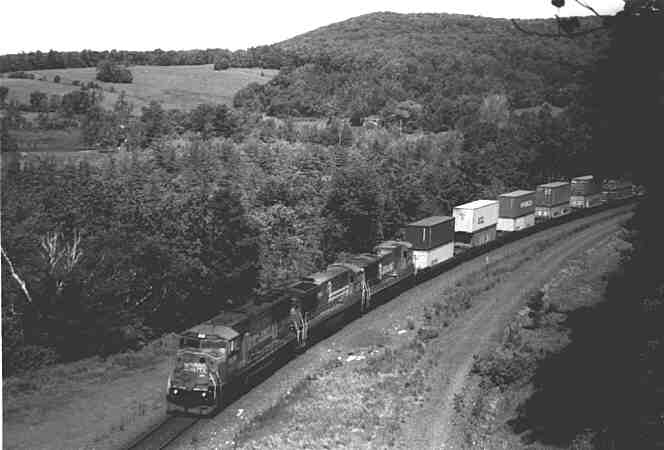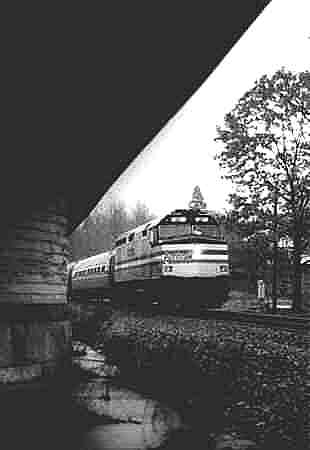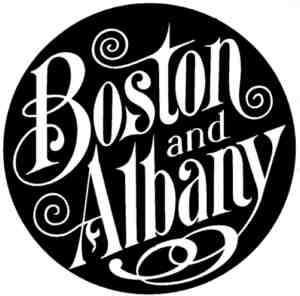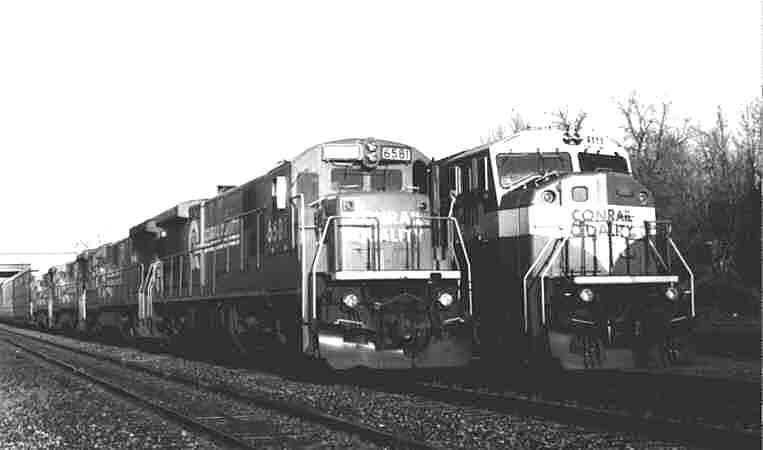This website has been archived from TrainWeb.org/tylick to TrainWeb.US/tylick.
This website has been archived from TrainWeb.org/tylick to TrainWeb.US/tylick.

Along The B&A
Background
In colonial times the preeminent seaport of America, Boston never recovered its position of leadership after the British embargoes during the War of 1812. New York, with easy river access to Albany, was growing rapidly in importance. With the opening of the Erie Canal in 1825, New York had a water route all the way to the Great Lakes. The dislike of new York can be seen even today when one considers the vehemence with which Boston Red Sox fans detest the New York Yankees. A canal across the rugged mountains of western New England was unthinkable, but a railroad was a possibility. Taking the lead of Baltimore, which was in very much the same situation, the Massachusetts Legislature was debating the funding of such a railroad by 1827 and argued the matter until 1830. Once it was established the new railroad was to be built with private funding, it didn’t take long for charter petitions to appear.
The
Boston
and Worcester Railroad began construction in August 1832 and reached
its
destination in 1835, just five years after the completion of the
Baltimore
and Ohio. The B&W’s charter only extended forty-five miles
from
Boston, so its  directors
incorporated individually as the Western Railroad in 1833, which was to
complete the two hundred mile route to Albany. Because of the
usual
political and financial pitfalls in starting such a large undertaking
construction
was not started until the winter of 1836. Springfield and the
Connecticut
River Valley were reached on October 1, 1839. By 1841 a
connection
was made with the Hudson and Berkshire Railway into Albany. By
the
end of the year, a more direct route to Albany became available when
the
Albany & West Stockbridge completed the State Line Tunnel.
directors
incorporated individually as the Western Railroad in 1833, which was to
complete the two hundred mile route to Albany. Because of the
usual
political and financial pitfalls in starting such a large undertaking
construction
was not started until the winter of 1836. Springfield and the
Connecticut
River Valley were reached on October 1, 1839. By 1841 a
connection
was made with the Hudson and Berkshire Railway into Albany. By
the
end of the year, a more direct route to Albany became available when
the
Albany & West Stockbridge completed the State Line Tunnel.
It is difficult for us to today imagine the magnitude of this undertaking. Railroads were a new and unproven technology, and the costs for a line of any size was beyond the resources of even the wealthiest of individuals. Railroads became the first modern corporations with stockholders and directors. Unlike many later rail lines which were ravaged by the Robber Barons, Boston and Albany stock always remained in the possession of the Boston Brahmins who subscribed in the first place. Indeed, the stock, if held to this day would have increased seven times in value over its lifetime. Surmounting the Berkshire Mountains by the western Railroad was a great engineering feat in its day. The railroad reached its summit in Washington, Mass at an elevation of 1,459 feet above sea level with no grades in excess of 1.67 percent. Chief engineer George Washington Whistler (the father of the well-known artist James McNeil Whistler) went on to build the Moscow-Petersburg Railroad in Russia. Built for double track from the outset, this well designed route has received only one realignment, a two mile stretch in Middlefield, Mass to ease grades and curvature.
Charter restrictions kept the two railroads apart for thirty years, but in 1863 the Boston and Worcester’s route monopoly ended and the western Railroad proposed to extend its tracks into Boston. By the time the politicians and financiers were finished, it was September 4, 1867 before the two railroads were merged and the Boston and Albany Railroad was created. Its first president was Chester W. Chapin, president of the Western Railroad.
These
enterprises were successful from the very beginning, tapping the
ever-growing
manufacturing base of New England and the fertile Connecticut River
Valley.
By 1880, the B&A was interchanging large amounts of east-west
traffic
with the New York Central. Over two-thirds of its income came
from
this source. In March of that year, an agreement was reached
between
the two companies which treated interchange traffic as if it were
running
on one railroad. Both, however, retained ownership of their
property
and profits. This agreement remained in effect until the Boston
and
Albany was officially leased to the New York Central System on
September
26, 1900.
The citizens of Massachusetts did not take kindly to the “foreign” intruders, and the New York Central found it necessary to retain the Boston and Albany name on the sides of the locomotives until the end of the steam era. Only one small group of diesel switchers were ever lettered for the Boston and Albany. To its credit, the New York Central kept the B&A well-maintained and powered its trains with new locomotives. The 2-8-4 Berkshire wheel arrangement was named for the mountains this engine type first crossed. Passenger service saw improved diner and club car service, and Boston sections of the Southwestern Limited, Wolverine, and Western Express were added to the timetable. The flagship of the fleet was the New England States, the direct Boston to Chicago equivalent of the Twentieth Century Limited. A third track was even added to portions of Washington Hill to facilitate movement of these trains.
The B&A remained autonomous until the 1950's when the New York Central found it expedient to merge the property into the parent company. On April 3, 1961, the Boston and Albany Railroad ceased to exist, now part of the New York Central. Shortly afterwards, on February 1,1968, the New York Central became part of the Penn-Central Railroad with the Pennsylvania and New Haven railroads as the other principals. Penn Central only lasted twenty-eight months before it entered into one of the largest bankruptcies in corporate history. Operation continued with the infusion of guaranteed Federal loans until April 1, 1976 when the Consolidated rail Corporation was formed, encompassing much of the eastern rail scene. In an unusual case of successful government involvement, Conrail was operating in the black by 1983 and became a public corporation once again in 1987. In March 1998 Conrail was purchased and split up between the CSX Corporation and the Norfolk Southern for an inflated price in excess of ten billion dollars. It was a case of neither railroad being willing to allow the other sole access to the New York City area. As of early 1999, the owners had yet to take control of the day to day operations of the Conrail system. S of this writing, the official takeover date is March 31, 1999. We wonder how the chauvinistic New Englanders of the turn of the last century would feel about their railroad under the ownership of an enormous corporation based in Richmond, Virginia.
Please follow these links for a large B&A system map c. 1930. EAST END | WEST END
Present-Day Operations
The Boston Line, as the B&A is called by Conrail, is the primary
freight
route into New England. An average of twenty-four through trains
ply its rails each day with a diverse selection of merchandise and
intermodal
trains. The double and triple track mainline was single tracked
in
1987 and a modern computed aided dispatching system was installed when
the dispatching offices for the Albany Division were consolidated at
Selkirk
Yard, near Albany. With the exception of interlocking signals, no
wayside block signals appear along the route west of the Framingham
commuter
zone.  Commuter
service is very well used, with five daily trains operated as far west
as Worcester by the Massachusetts Bay Transit Authority (MBTA) known as
“the T” by locals.
Commuter
service is very well used, with five daily trains operated as far west
as Worcester by the Massachusetts Bay Transit Authority (MBTA) known as
“the T” by locals.
The Boston and Albany was used as a test bed for then state of the art cab signal systems at the time, and all trains must be lead by a suitably equipped locomotive. For this reason, foreign power never leads a train on the B&A. Since all merchandise trains originate at Selkirk Yard, and most intermodal trains are assigned new power at Selkirk (the B&A was the only mountain line on the New York Central’s Water Level Route) foreign power is unusual at any time. For this reason, the Boston and Albany is expected to be one of the last places on former Conrail lines to see all blue engines leading trains. Although the CSX-CR power mix took place overnight, former Conrail units still lad trains, with the exception of a number of GP40-2 locomotives that were brought up from the cab signalled RF&P. Most B&A trains are lead by four high horsepower six axle diesels or about 12,000 horsepower. Stiff grades make dynamic braking a must on this line. Although any unit owned by Conrail could be seen, General Electric C30-7 units predominated. The rare C32-8 units and the new EMD SD80MAC ac locomotives were also common in the B&A power pool. Power assignements seem to be more eclectic under CSX. Train lengths vary, but freights longer than fifty cars are the norm and one hundred car trains are not unusual.
Since manufacturing fled the Northeast after World War II for the south (and now for the Third World) in search of inexpensive, non-union labor, eastern railroads have been plagued by the lack of traffic originating on their lines. This traffic pays a higher percentage than traffic is merely delivered, and there are no major industries located on the B&A. The largest single customer is United Parcel, who maintains a large bulk sorting facility in Shrewsbury, near Worcester. So the predominant flow of traffic is loads in and empties out. Since the on-line distances involved were relatively short, Conrail had never actively sought North-South traffic, but the new owners hope to be able to tap this large market. Intermodal ramps are located at West Springfield, Palmer, Worcester, and Boston.. New automobile unloading takes place at Westboro, Framingham, and at Ayer, where Conrail has trackage rights on the Guilford Transportation System. Local freights operate out of Pittsfield, West Springfield, Worcester, Framingham, Readville, and Boston.
Interchanges abound in New England, where at one time rail lines seemed to cross each other almost every other mile. Although much of this track is now abandoned, interchange is maintained with the Housatonic Railroad at Pittsfield, the Pioneer Valley Railroad at Westfield, the Connecticut Southern at West Springfield, the New England Central Railroad at Palmer, the Providence and Worcester Railroad and Guilford Transportation at Worcester, and the Quincy Bay Terminal railroad at Boston. Cars are delivered along the Framingham Secondary Route to the Bay Colony Railroad and the Cape Cod Railroad.
 In addition, Amtrak operates the daily Lake Shore Limited, a Boston to
Chicago overnight train that connects with a New York section in much
the
same way as was done under the New York Central. A Boston to
Washington
passenger train operates via the Inland Route, following the B&A
from
Boston to Springfield, where it turns south on Amtrak lines towards New
Haven. Springfield Amtrak station is an important terminus for
Amtrak
which sees twelve other passenger trains a day, including two Vermont
trains.
In addition, Amtrak operates the daily Lake Shore Limited, a Boston to
Chicago overnight train that connects with a New York section in much
the
same way as was done under the New York Central. A Boston to
Washington
passenger train operates via the Inland Route, following the B&A
from
Boston to Springfield, where it turns south on Amtrak lines towards New
Haven. Springfield Amtrak station is an important terminus for
Amtrak
which sees twelve other passenger trains a day, including two Vermont
trains.
One of the oldest railroads in the country, and one of the very first mountain railroads, Conrail’s Boston Line (still known as “the B&A” to railfans and operating crews alike) combines a sense of history with the excitement of present day mainline railroading, connecting the coastal urbanized spread of eastern Massachusetts with the wild beauty of the West End and the Hudson River. It is at the top of our list of favorites and we hope you will enjoy this brief tour.
